Effects of Different Green Manure Crops on Soil Water, Nitrogen, and Yield: Preliminary Results in an Apple Orchard on the Loess Plateau, China
Abstract
1. Introduction
2. Materials and Methods
2.1. Study Area
2.2. Experimental Design
2.3. Measurements and Calculations
2.3.1. Soil Water Content (SWC) Measurements
2.3.2. Soil Nutrient Content Determinations
2.3.3. 15N Isotope Abundance Determinations
2.3.4. Nitrogen-Efficiency Determinations
2.3.5. Soil Water Storage (SWS)
2.3.6. Soil Water Difference Ratio (SWDR) [25]
2.3.7. Evapotranspiration (ET) and Water Use Efficiency (WUE)
2.3.8. Fruit Yield and Quality
2.3.9. Data Analysis
3. Results
3.1. Variation of Soil Water, TN, and SOM Contents
3.1.1. SWC Change
3.1.2. Distribution of TN and SOM Contents
3.2. Water and Nitrogen Competition of Intercropping System
3.2.1. Water Competition
3.2.2. Nitrogen Competition
3.3. Yield, WUE, and Fruit Quality
4. Discussion
4.1. Effects of Different Green Manure Crops on Soil Moisture and Fertility
4.2. Water and Nitrogen Competition of Intercropping Systems
4.3. Effects of Different Green Manure Crops on Yield, WUE, and Apple Quality
5. Conclusions
Author Contributions
Funding
Data Availability Statement
Acknowledgments
Conflicts of Interest
References
- FAOSTAT. 2021. Available online: https://www.fao.org/faostat/en/ (accessed on 11 March 2023).
- Liu, Y.; Gao, M.; Wu, W.; Tanveer, S.K.; Wen, X.; Liao, Y. The effects of conservation tillage practices on the soil water-holding capacity of a non-irrigated apple orchard in the Loess Plateau, China. Soil Till. Res. 2013, 130, 7–12. [Google Scholar] [CrossRef]
- Zheng, W.; Wen, M.; Zhao, Z.; Liu, J.; Wang, Z.; Zhai, B.; Li, Z. Black plastic mulch combined with summer cover crop increases the yield and water use efficiency of apple tree on the rainfed Loess Plateau. PLoS ONE 2017, 12, e0185705. [Google Scholar] [CrossRef] [PubMed]
- Ge, S.; Xu, H.; Ji, M.; Jiang, Y. Characteristics of Soil Organic Carbon, Total Nitrogen, and C/N Ratio in Chinese Apple Orchards. Open J. Soil Sci. 2013, 3, 213–217. [Google Scholar] [CrossRef]
- Coronado, A.; Linares, C.; López, M.; Ángel, F.; Zornoza, R. The impact of intercropping, tillage and fertilizer type on soil and crop yield in fruit orchards under Mediterranean conditions: A meta-analysis of field studies. Agric. Syst. 2020, 178, 102736. [Google Scholar] [CrossRef]
- Yves, B.; Lecomte, V.E.; Olivier, C. Grass strip effects on runoff and soil loss. Agron 2004, 24, 129–136. [Google Scholar] [CrossRef]
- Uliarte, E.; Schultz, H.; Frings, C.; Pfister, M.; Parera, C.; Monte, R. Seasonal dynamics of CO2 balance and water consumption of C3 and C4-type cover crops compared to bare soil in a suitability study for their use in vineyards in Germany and Argentina. Agric. For. Meteorol. 2013, 181, 1–16. [Google Scholar] [CrossRef]
- Elhakeem, A.; Werf, W.; Ajal, J.; Lucà, D.; Claus, S.; Vico, R.; Bastiaans, L. Cover crop mixtures result in a positive net biodiversity effect irrespective of seeding configuration. Agric. Ecosyst. Environ. 2019, 285, 106627. [Google Scholar] [CrossRef]
- Li, H.; Zhang, G.; Zhao, Z.; Li, K. Effects of Different Herbage on Soil Quality Characteristics of Non-Irrigated Apple Orchard in Weibei Loess Plateau. Sci. Agric. Sin. 2008, 7, 2070–2076. [Google Scholar] [CrossRef]
- Zhang, X.; Li, H.; Zhao, G.; Zhao, Z. Effects of Interplanting Different Herbageon Soil Moisture in Apple Orchards of Weibei Plateau. J. Northwest For. Univ. 2005, 3, 56–59. [Google Scholar] [CrossRef]
- Huang, J.; Wang, J.; Zhao, X.; Wu, P.; Qi, Z.; Li, H. Effects of permanent ground cover on soil moisture in jujube orchards under sloping ground: A simulation study. Agric. Water Manag. 2014, 138, 68–77. [Google Scholar] [CrossRef]
- Hernández, A.; Lacasta, C.; Pastor, J. Effects of different management practices on soil conservation and soil water in a rainfed olive orchard. Agric. Water Manag. 2005, 77, 232–248. [Google Scholar] [CrossRef]
- Qian, X.; Gu, J.; Pan, H.-J.; Zhang, K.-Y.; Sun, W.; Wang, X.-J.; Gao, H. Effects of living mulches on the soil nutrient contents, enzyme activities, and bacterial community diversities of apple orchard soils. Eur. J. Soil Biol. 2015, 70, 23–30. [Google Scholar] [CrossRef]
- Ren, J.; Li, F.; Yin, C. Orchard grass safeguards sustainable development of fruit industry in China. J. Clean. Product. 2023, 382, 135291. [Google Scholar] [CrossRef]
- Xiang, Y.; Li, Y.; Liu, Y.; Zhang, S.; Yue, X.; Yao, B.; Xue, J.; Lv, W.; Zhang, L.; Xu, X.; et al. Factors shaping soil organic carbon stocks in grass covered orchards across China: A meta-analysis. Sci. Total Environ. 2022, 807, 150632. [Google Scholar] [CrossRef] [PubMed]
- Yang, J.; Duan, Y.; Zhang, R.; Liu, C.; Wang, Y.; Li, M.; Ding, Y.; Awasthi, M.; Li, H. Connecting soil dissolved organic matter to soil bacterial community structure in a long-term grass-mulching apple orchard. Ind. Crops Prod. 2020, 149, 112344. [Google Scholar] [CrossRef]
- Suo, G.-D.; Xie, Y.-S.; Zhang, Y.; Luo, H. Long-term effects of different surface mulching techniques on soil water and fruit yield in an apple orchard on the Loess Plateau of China. Sci. Hortic. 2019, 246, 643–651. [Google Scholar] [CrossRef]
- Fang, K.; Li, H.; Wang, Z.; Dua, Y.; Wang, J. Comparative analysis on spatial variability of soil moisture under different land use types in orchard. Sci. Hortic. 2016, 207, 65–72. [Google Scholar] [CrossRef]
- Li, H.; Zhang, G.; Zhao, Z.; Li, K. Effects of interplanted herbage on soil properties of nonirrigated apple orchards in the Loess Plateau. Acta Prat. Sin. 2007, 2, 32–39. [Google Scholar] [CrossRef]
- Du, S.; Bai, G.; Yu, J. Soil properties and apricot growth under intercropping and mulching with erect milk vetch in the loess hilly-gully region. Plant Soil 2014, 390, 431–442. [Google Scholar] [CrossRef]
- Bao, S. Soil Agricultural Chemistry Analysis; China Agriculture Press: Beijing, China, 2013. [Google Scholar]
- Li, F. Forest Mensuration; China Forestry Publishing House: BeiJing, China, 2019. [Google Scholar]
- Lv, J. Study on Biomass and Carbon Absorption of Apple in the Residual Gully Area of Economic Forest Shaanxi Province. Master’s Thesis, Inner Mongolia Agricultural University, Hohhot, China, 2019. [Google Scholar]
- Junk, G.; Svec, H. The absolute abundance of the nitrogen isotopes in the atmosphere and compressed gas from various sources. Geochim. Et Cosmochim. Acta 1958, 14, 234–243. [Google Scholar] [CrossRef]
- Ling, Q.; Gao, X.; Zhao, X.; Huang, J.; Li, H.; Li, L.; Sun, W.; Wu, P. Soil water effects of agroforestry in rainfed jujube (Ziziphus jujube Mill.) orchards on loess hillslopes in Northwest China. Agric. Ecosyst. Environ. 2017, 247, 343–351. [Google Scholar] [CrossRef]
- Shi, J.; Xun, M.; Song, J.; Zhang, W.; Fan, W.; Yang, H. Regulation effects of carbonized apple branches on absorption, distribution, and utilization of 15N single-labeled ammonium nitrate 15NH4NO3 or NH415NO3) in Malus hupehensis. Plant Physiol Biochem 2022, 186, 197–206. [Google Scholar] [CrossRef] [PubMed]
- Peng, L.; Wen, Z.; An, X.; Jiang, H.; Jiang, Y. Effects of Interplanting grass on utilization, loss and accumulation of 15N in apple orchard. Acta Pedol. Sin. 2015, 52, 901143. [Google Scholar] [CrossRef]
- Zheng, Z.; Wang, Y.; Gong, Q.; Zheng, W.; Zhao, Z.; Zhai, B.; Han, M. Absorption, distribution and utilization of soil applied 15N-urea in young dwarf rootstock ‘Fuji’ apple trees. J. Plant Nutr. Fert. 2018, 24, 237–244. [Google Scholar] [CrossRef]
- Ge, S.; Jiang, Y.; Wei, S.; Fang, X. Nitrogen balance under different nitrogen application rates in young apple orchards. J. Plant Nutr. Fert. 2011, 17, 949–955. [Google Scholar] [CrossRef]
- Zhao, L.; Gao, X.; He, N.; Zhao, X. Ecohydrological advantage of young apple tree-based agroforestry and its response to extreme droughts on the semiarid Loess Plateau. Agric. For. Meteorol. 2022, 321, 108969. [Google Scholar] [CrossRef]
- Delpuech, X.; Metay, A. Adapting cover crop soil coverage to soil depth to limit competition for water in a Mediterranean vineyard. Eur. J. Agron. 2018, 97, 60–69. [Google Scholar] [CrossRef]
- Ramos, M.E.; Robles, A.B.; Navarro, A.; Rebollar, J. Soil responses to different management practices in rainfed orchards in semiarid environments. Soil Till. Res. 2011, 112, 85–91. [Google Scholar] [CrossRef]
- Virk, A.L.; Lin, B.-J.; Kan, Z.-R.; Qi, J.-Y.; Dang, Y.P.; Lal, R.; Zhao, X.; Zhang, H.-L. Simultaneous effects of legume cultivation on carbon and nitrogen accumulation in soil. Adv. Agron. 2022, 171, 75–110. [Google Scholar] [CrossRef]
- Wen, Z. The Influence of Planting Alfalfa on The Physico-Chemical Characteristics of Soil. Master’s Thesis, Northwest A&F University, Yangling, China, 2008. [Google Scholar]
- Li, H.; Li, J.; Wang, L.; Cao, W.; Mei, L. Effects of Interspecific Interaction on the Growth and Distribution of Roots in Apple-White Clover Intercropping System. Acta Agrestia Sin. 2011, 19, 960–968. [Google Scholar]
- He, Z.; Hu, Q.; Zhang, Y.; Cao, H.; Nan, X. Effects of irrigation and nitrogen management strategies on soil nitrogen and apple yields in loess plateau of China. Agric. Water Manag. 2023, 280, 108220. [Google Scholar] [CrossRef]
- El Jaouhari, N.; Abouabdillah, A.; Bouabid, R.; Bourioug, M.; Aleya, L.; Chaoui, M. Assessment of sustainable deficit irrigation in a Moroccan apple orchard as a climate change adaptation strategy. Sci. Total Environ. 2018, 642, 574–581. [Google Scholar] [CrossRef] [PubMed]
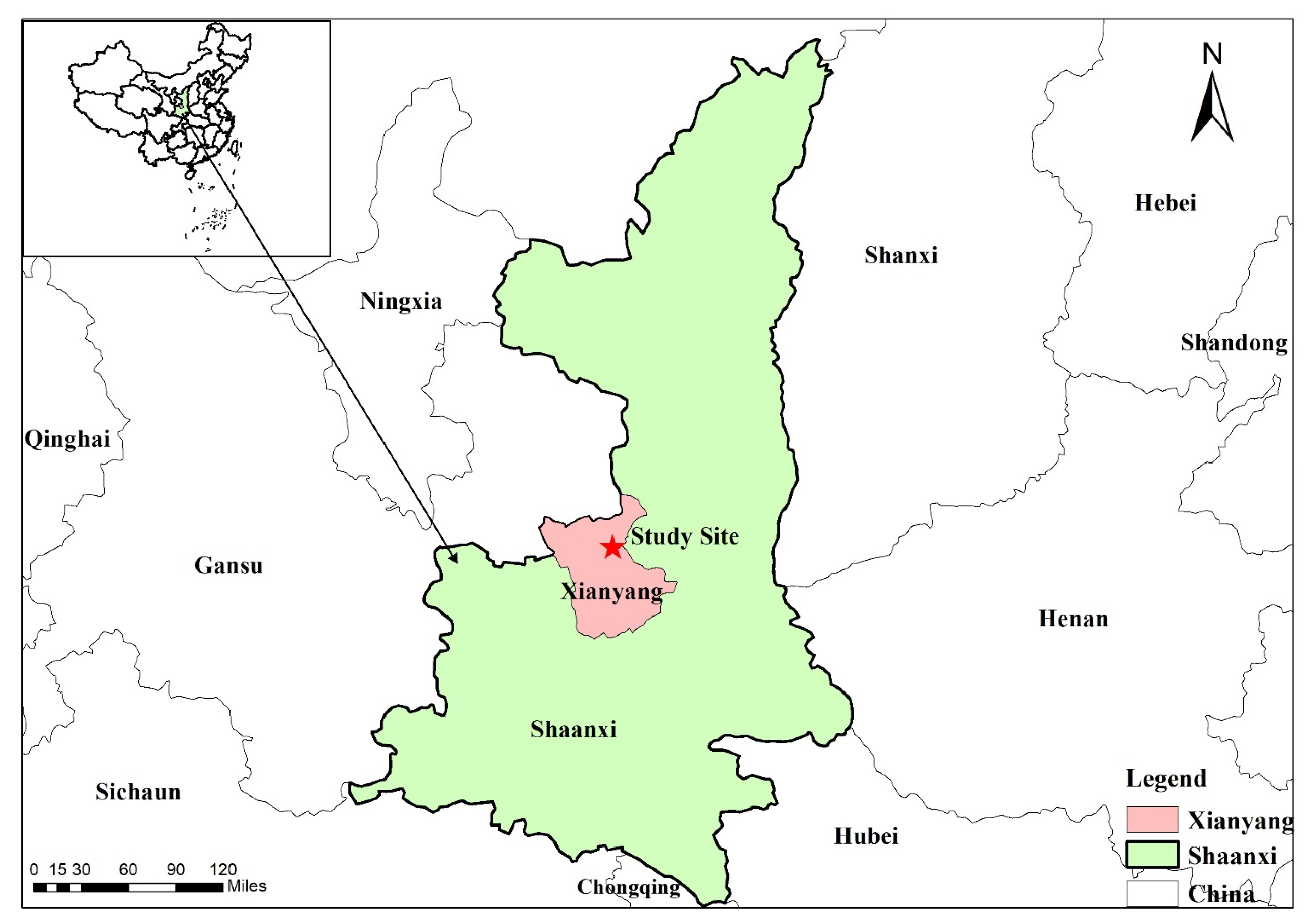
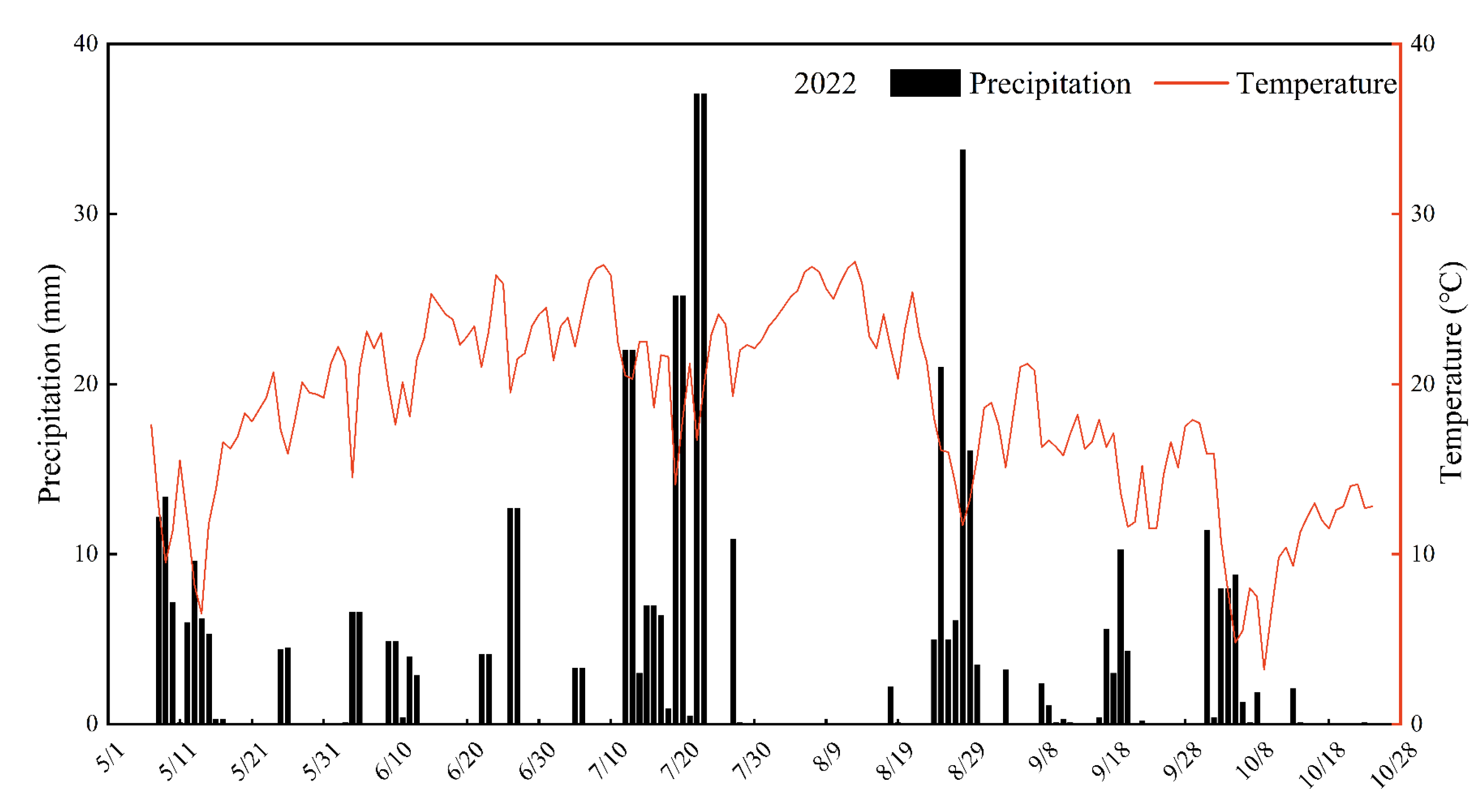
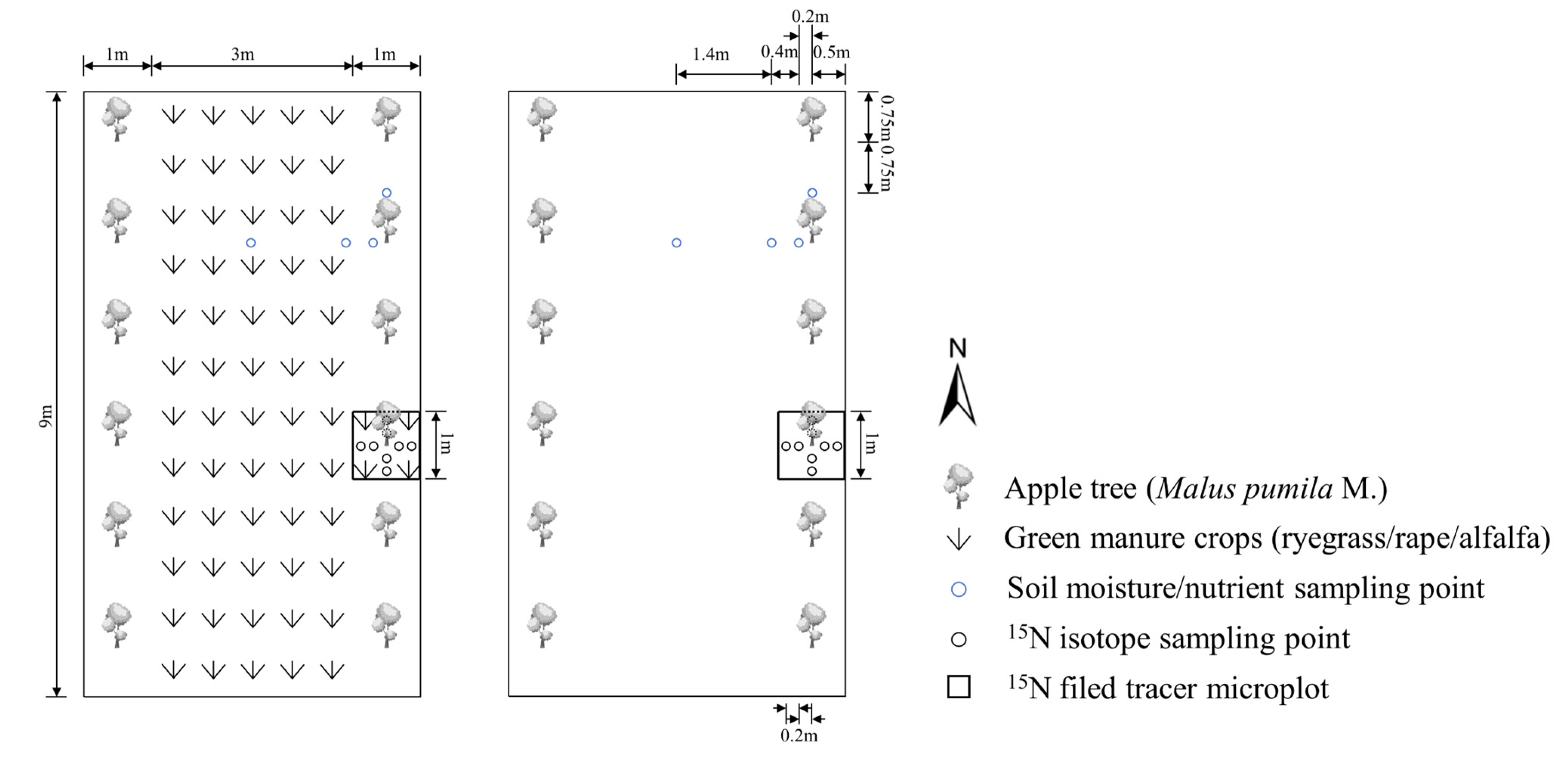
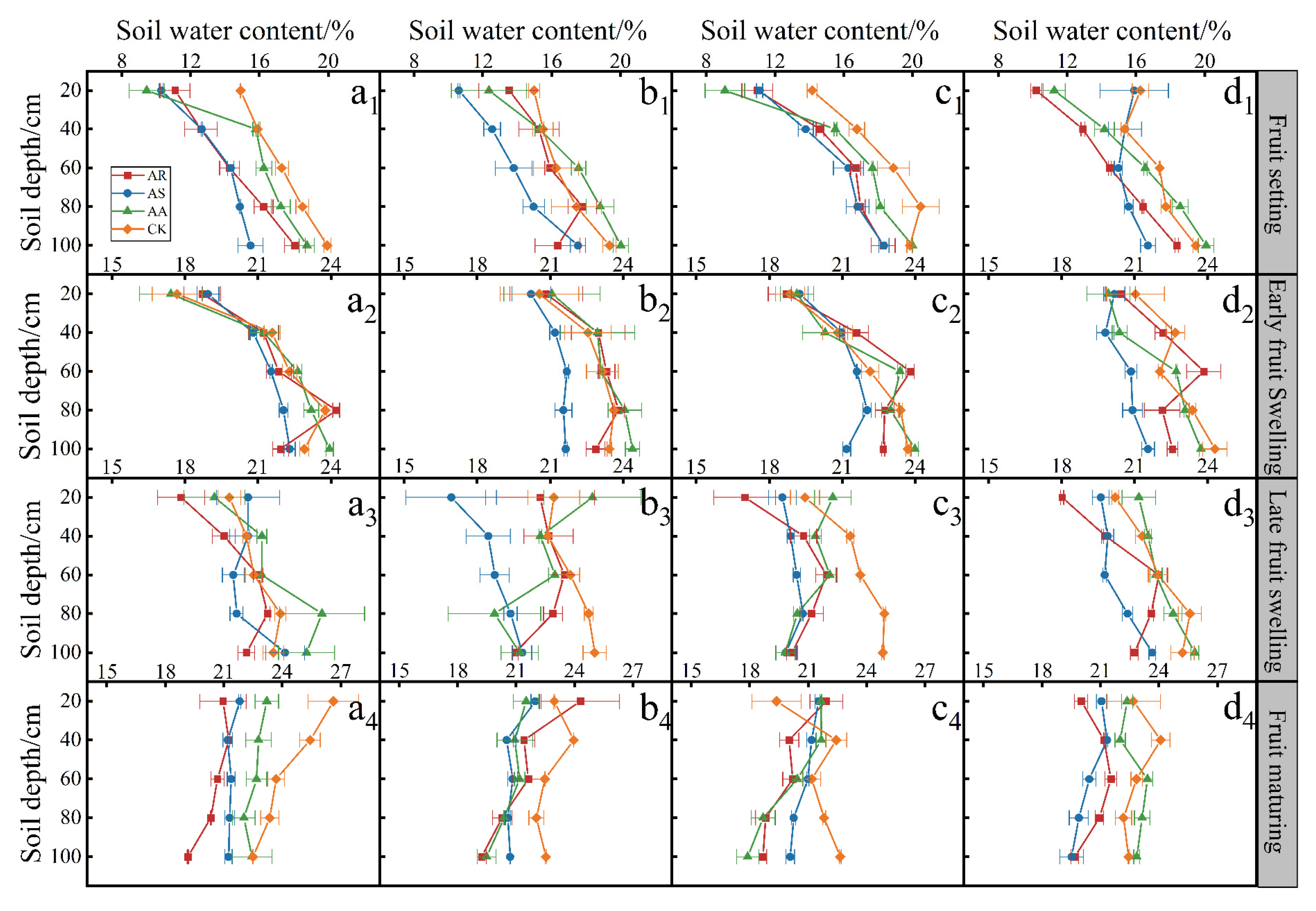
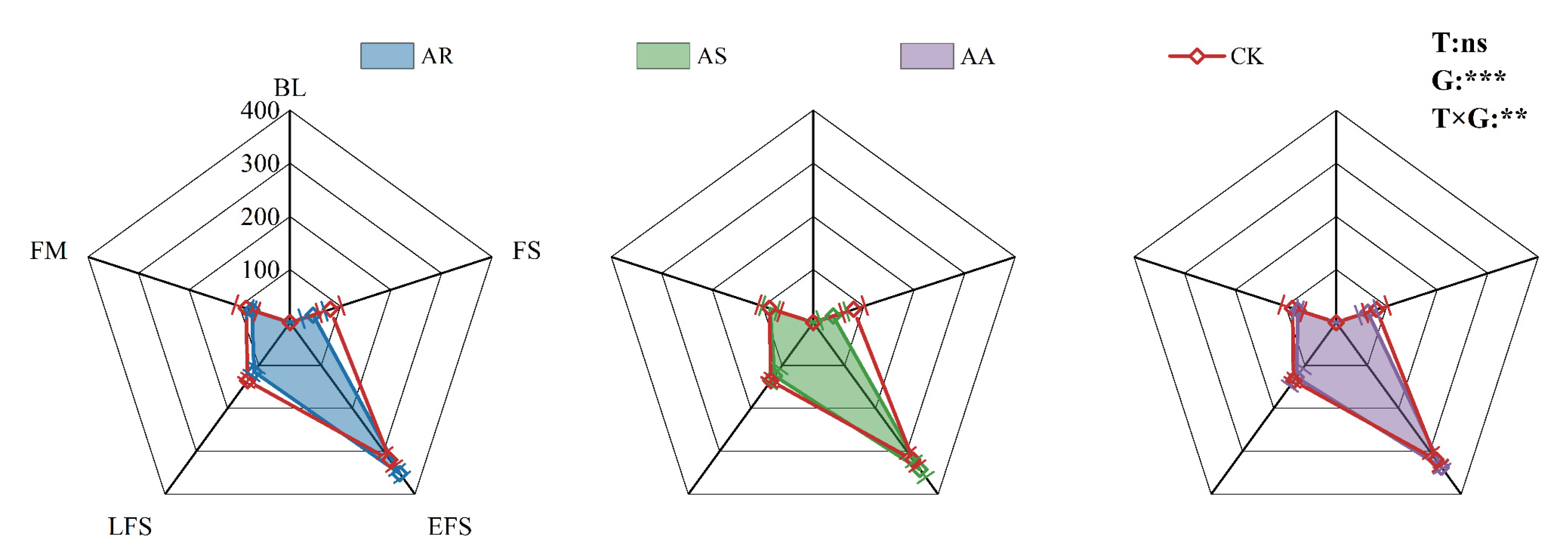
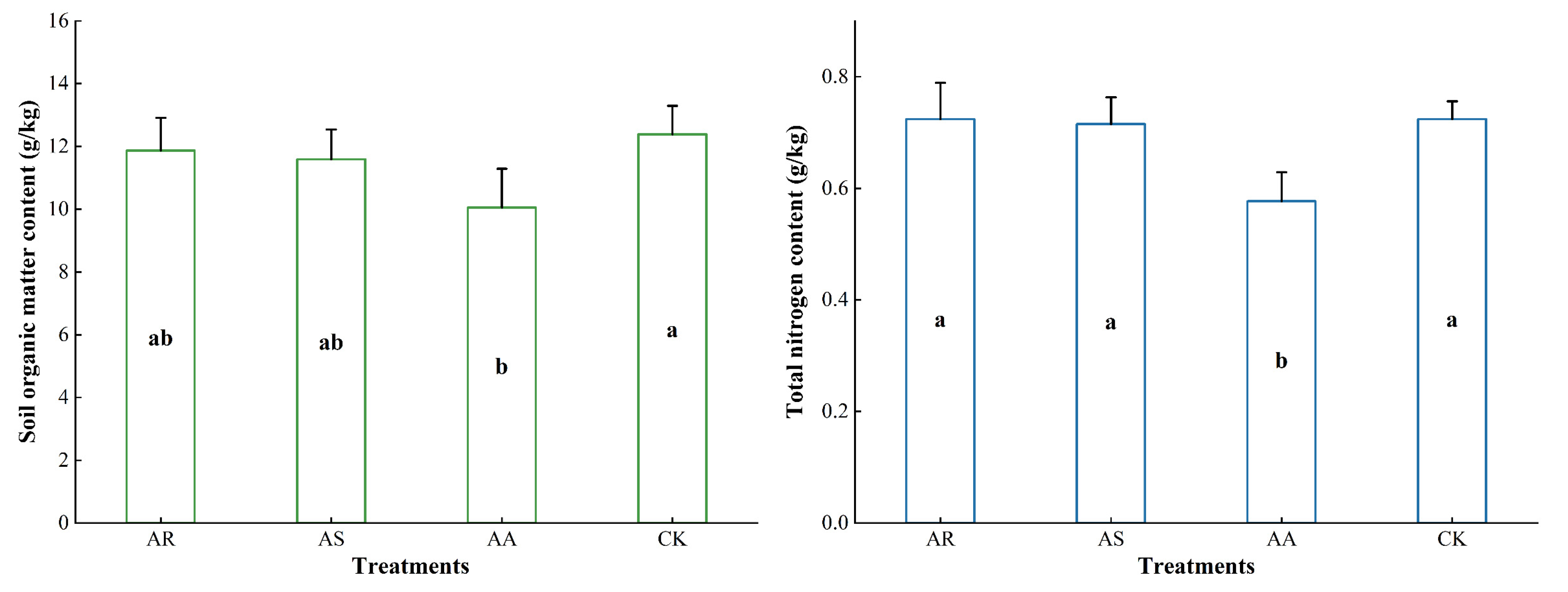
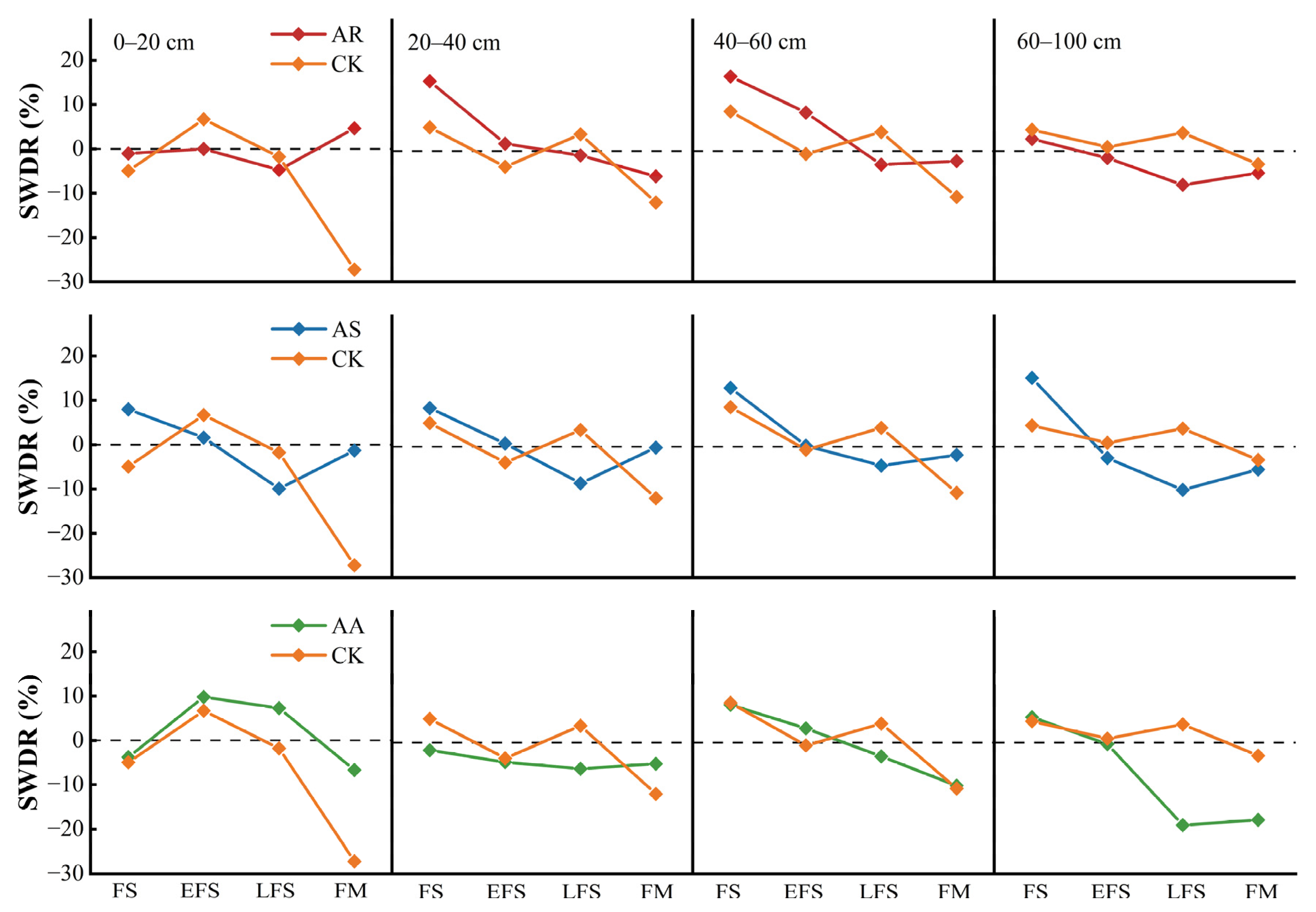
| Organs | a | b | R2 | Prediction Accuracy/% |
|---|---|---|---|---|
| Stem | 0.019 | 0.962 | 0.989 | 83.16 |
| Branch | 0.009 | 1.086 | 0.982 | 80.08 |
| Root | 0.015 | 0.976 | 0.971 | 87.91 |
| Growth Period | T | SD | P | T × SD | T × P | SD × P | T × SD × P |
|---|---|---|---|---|---|---|---|
| Fruit setting | *** | *** | ns | *** | ** | ** | * |
| Early fruit swelling | *** | *** | ns | *** | ns | ns | ns |
| Late fruit swelling | *** | *** | ** | *** | *** | * | ns |
| Fruit maturing | *** | *** | *** | ** | *** | * | *** |
| Index | AR | AS | AA | CK |
|---|---|---|---|---|
| Yield (kg ha−1) | 50,375 ± 2625 a | 47,667 ± 2524 a | 42,000 ± 3437a | 45,111 ± 2959 a |
| ET (mm) | 587.9 ± 11.6 a | 592.0 ± 15.3 a | 601.7 ± 12.2 a | 602.6 ± 13.2 a |
| WUE (kg ha−1 mm−1) | 85.7 ± 1.7 a | 80.5 ± 2.1 ab | 69.8 ± 1.4 c | 74.9 ± 1.8 bc |
| Treatments | 15NUEOrgan(%) | 15NUEAt(%) | 15NRE(%) | 15NUEGmc(%) | 15NLE(%) | ||||
|---|---|---|---|---|---|---|---|---|---|
| Leaves | Branch | Stem | Root | Fruit | |||||
| AR | 0.84 ± 0.07 a | 8.15 ± 0.36 a | 1.53 ± 0.09 c | 10.29 ± 0.30 a | 3.56 ± 0.28 b | 24.37 ± 1.53 a | 10.45 ± 0.96 c | 19.71 ± 0.95 c | 45.47 ± 2.49 b |
| AS | 0.70 ± 0.05 b | 4.19 ± 0.29 b | 3.47 ± 0.15 a | 7.89 ± 0.37 c | 3.83 ± 0.20 ab | 20.08 ± 0.96 b | 15.84 ± 1.11 b | 29.24 ± 1.65 b | 34.84 ± 1.83 c |
| AA | 0.43 ± 0.03 d | 4.40 ± 0.31 b | 1.80 ± 0.06 b | 8.91 ± 0.39 b | 4.19 ± 0.15 a | 19.74 ± 0.85 bc | 26.85 ± 1.45 a | 39.42 ± 2.21 a | 14.00 ± 0.83 d |
| CK | 0.53 ± 0.03 c | 3.87 ± 0.15 b | 1.44 ± 0.10 c | 9.59 ± 0.48 ab | 1.87 ± 0.12 c | 17.30 ± 0.96 c | 10.55 ± 0.67 c | 72.16 ± 3.25 a | |
| Treatment | Titratable Acid (%) | Soluble Sugar (g/kg) | VC (mg/kg) |
|---|---|---|---|
| AR | 0.24 ± 0.01 a | 144.55 ± 10.10 a | 4.51 ± 0.90 a |
| AS | 0.24 ± 0.02 a | 140.93 ± 12.39 a | 5.71 ± 0.52 a |
| AA | 0.24 ± 0.04 a | 160.75 ± 20.76 a | 4.51 ± 1.80 a |
| CK | 0.23 ± 0.01 a | 137.13 ± 8.47 a | 5.71 ± 0.52a |
Disclaimer/Publisher’s Note: The statements, opinions and data contained in all publications are solely those of the individual author(s) and contributor(s) and not of MDPI and/or the editor(s). MDPI and/or the editor(s) disclaim responsibility for any injury to people or property resulting from any ideas, methods, instructions or products referred to in the content. |
© 2023 by the authors. Licensee MDPI, Basel, Switzerland. This article is an open access article distributed under the terms and conditions of the Creative Commons Attribution (CC BY) license (https://creativecommons.org/licenses/by/4.0/).
Share and Cite
Liang, Q.; Zhang, T.; Liu, Z.; Gao, W.; Cheng, Y.; Feng, H. Effects of Different Green Manure Crops on Soil Water, Nitrogen, and Yield: Preliminary Results in an Apple Orchard on the Loess Plateau, China. Agronomy 2023, 13, 2009. https://doi.org/10.3390/agronomy13082009
Liang Q, Zhang T, Liu Z, Gao W, Cheng Y, Feng H. Effects of Different Green Manure Crops on Soil Water, Nitrogen, and Yield: Preliminary Results in an Apple Orchard on the Loess Plateau, China. Agronomy. 2023; 13(8):2009. https://doi.org/10.3390/agronomy13082009
Chicago/Turabian StyleLiang, Qing, Tibin Zhang, Zhenyuan Liu, Weiqiang Gao, Yu Cheng, and Hao Feng. 2023. "Effects of Different Green Manure Crops on Soil Water, Nitrogen, and Yield: Preliminary Results in an Apple Orchard on the Loess Plateau, China" Agronomy 13, no. 8: 2009. https://doi.org/10.3390/agronomy13082009
APA StyleLiang, Q., Zhang, T., Liu, Z., Gao, W., Cheng, Y., & Feng, H. (2023). Effects of Different Green Manure Crops on Soil Water, Nitrogen, and Yield: Preliminary Results in an Apple Orchard on the Loess Plateau, China. Agronomy, 13(8), 2009. https://doi.org/10.3390/agronomy13082009







